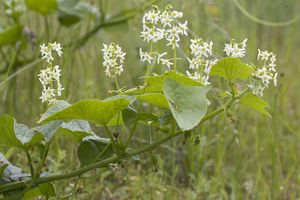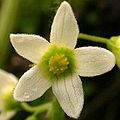Marah oregana
- Scientific Name: Marah oregana
- Family: Cucurbitaceae
- Common Names: coastal manroot, wild cucumber
- Synonyms/Misapplications: Echinocystis oregana, Marah oreganus, Sicyos oregana, Megarrhiza oregana, Micrampelis
oregana - Codon: MARORE
Contents
Taxonomy
| Scientific classification | |
|---|---|
| Kingdom: | Plantae |
| Subkingdom: | Viridiplantae |
| Phylum: | Tracheophyta |
| Subphylum: | Spermatophytina |
| Class: | Magnoliopsida |
| Subclass: | Rosanae |
| Order: | Cucurbitales |
| Family: | Cucurbitaceae |
| Genus: | Marah Kellogg |
| Species: | Marah oregana (Torr. & A. Gray) Howell |
| Synonyms | |
| |
Description
Native perennial, trailing or climbing with tendrils.
Leaves are alternate, palmately lobed, rough and hairy, and cordate at the base.
Flowers are unisexual, corolla campanulate and white, monoecious.
The bladder-like fruits are sparsely to densely covered with flexible prickles that harden with age, dehiscent at apex when dry. [2]
Name comes from Hebrew marah, bitter, from the intensely bitter root.[3]
Bloom Period
April-June[4]
Distribution
Southwestern BC southwards, west of Cascade-Sierran acis, to northern California, eastwards in Columbia River Gorge, northeast Oregon, and rarely Hells Canyon. [3]
Habitat
Bottomlands and open slopes at low elevations.[3]
Uses
Squaxin use of an infusion of smashed stalks as a soak for sore hands, plant considered poisonous.[5]
Seed
Seed sample from: 2011
Average Measurement: 16.8 x 17 x 8.5
Measurement Range: L: 15 – 18, W: 16 – 18, D: 8 – 9
Features
Shape: Seeds very large, rounded with a pinched looking hilum.
Color: Dark brown, with a lighter brown hilum. Under high magnification seed appears speckled with black.
Surface: Seed covered in very fine velvety hairs. Under high magnification seed appears slightly glossy, but with naked eye, seed is matte.
Latitudinal Cross Section: elliptical ![]()
Longitudinal Cross Section: elliptical ![]()
Photo Gallery
References
- ↑ Integrated Taxonomic Information System. Retrieved from https://www.itis.gov/servlet/SingleRpt/SingleRpt?search_topic=TSN&search_value=847533
- ↑ Bowcutt, F., & Hamman, Sarah. (2016). Vascular plants of the South Sound prairies (First ed.). Olympia, Washington: The Evergreen State College Press.
- ↑ 3.0 3.1 3.2 Hitchcock, C. L., Cronquist, A., Giblin, D., & Legler, B. et al. (2018). Flora of the Pacific Northwest: an illustrated manual. Seattle: University of Washington Press.
- ↑ WTU Herbarium, Burke Museum, & University of Washington. Retrieved from https://biology.burke.washington.edu/herbarium/imagecollection/taxon.php?Taxon=Marah%20oregana
- ↑ Native American Ethnobotany Database. Retrieved from http://naeb.brit.org/uses/search/?string=marah+oreganus



